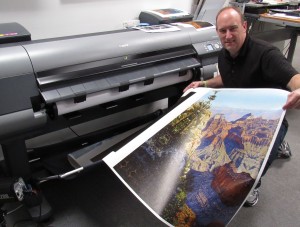
Bill Jay, longtime advocate for photography, famously said, “The best way for photographers to become rich and famous is to go into another field.”
He probably would not get much of an argument from modern members of this profession, especially in today’s digital world of picture-taking smartphones, easy-to-access photo-editing software, and ubiquitous social media that has changed how people capture, view and share photographs.
While professional photographers are not necessarily a dying breed, they do need to adapt or otherwise react to these changes in order to make a living. Flagstaff photographers Tom Alexander and Dawn Kish have done just this, following different paths in their individual quests to earn a living by doing what they love.
Alexander, a Phoenix native, remembers always wanting to be a photographer. He realized he could actually make money at it when he was about 15 years old, selling a portrait of a green chile for $100 at a school art sale. Academics played a significant role in his route to becoming a professional photographer. In high school, he participated in an international baccalaureate program in photography, spending two hours a day learning techniques. He then entered Northern Arizona University’s photography program in fall 1989.
“I was excited because I could ski and take pictures at the same time,” he said.
Alexander graduated in 1993, earning his degree in commercial photography with a minor in business. “The photography portion was great. That being said, I don’t do a lot of that anymore just because technology has changed over the last 26 years. The business side was critical because I learned how to market, promote and run a business.”
He learned a variety of photographic and development techniques while working at Silver Fox Studio downtown and later for photographers Peter Bloomer and Richard Jackson. Within a few years, he was spending most of his time in dark rooms, processing high-end slide prints.
“I started to become a mushroom and thought I had to do something else, so I went out on my own, operating out of an office over on Huntington.”
He became a photographic jack-of-all-trades – taking portraits, going on commercial shoots, creating ads – whatever clients needed.
For the past eight years, he has operated out of his office on South San Francisco Street, where he employs two people part time to help with canvas stretching, photo processing and restoration projects.
Alexander says the location has been good and is enhanced by the presence of a neighboring framing business, Hidden Light.
“People will bring paintings for me to photograph. I’ll create reproductions and giclées. They then go next door to have the work framed and shipped. It’s one-stop shopping.”
When Alexander started out, main focus of his business was portrait photography, but this has changed in response to the changing culture of the digital age. “When I worked at Silver Fox, there were 32 portrait photographers in the area and it was not uncommon to have an order of $2,000 for, say, graduation pictures. Nobody pays for this now, and in many cases people are taking their own pictures with their iPhones. There just isn’t nearly the need for portrait photographers that there once was.”
He still does some portraits, and also photographs landscape scenes, special events and artwork, but the largest percentage of his work is now in printing. He has experienced a growing demand for quality printing in the past several years and has purchased a 44-inch printer. This allows him to accurately process images and then print them out in his office. While printing provides business, he continues to look into the future to anticipate how customer needs will evolve so that he can acquire the appropriate technology to meet those needs.
Like Alexander, Dawn Kish is a Flagstaff photographer who is passionate about her craft. Despite boom-and-bust economic trends that often dictate the photography business, she has maintained her original focus.
A native of Flagstaff, Kish wanted to be a painter but, as she put it, “realized this was a weird wild card, so I turned to photography.” She received her first camera when she was 17. Five years later, she experienced the thrill of having her first photograph published in TransWorld Snowboarding Magazine.
Kish lived away from Flagstaff for years but moved back in 1998 to continue her career as a freelance photographer. She combines her sense of adventure with a dedication to photographing unique people, places and events.
Work has taken her around the world for clients such as National Geographic Adventure and Patagonia, but she remains based in Flagstaff, operating out of her home studio. Her greatest passion is documentary work.
“I love telling stories and documenting people and places and things, especially science,” she said. “When I’m documenting science, that means I’m getting to learn about the subject I’m photographing; I just feel like I’m a student all the time.”
Her biggest challenge is the fluctuation in demand. “You have to really trust that everything is going to be okay. You have to believe in yourself and that everything will work out. It’s not like ‘Here’s the work and here’s the career.’ It’s more like ‘Are you tough enough to not have a steady income?’”
For several years, she supplemented her income by working as a Grand Canyon boatman for the U.S. Geological Survey. This ignited a passion for the Grand Canyon and led to work photographing archaeological trips.
“There’s this thing inside you, this passion that you have for something, and sometimes you’re going to have to deal with maybe not paying your bills on time, or other times the phone rings off the hook and you have to turn clients away because you’re already so busy. To be a photographer, I think you have to be either crazy or relentless. I think I’m not crazy, I’m just relentless and believe things will work out the way they should.” FBN
By Kevin Schindler, FBN





